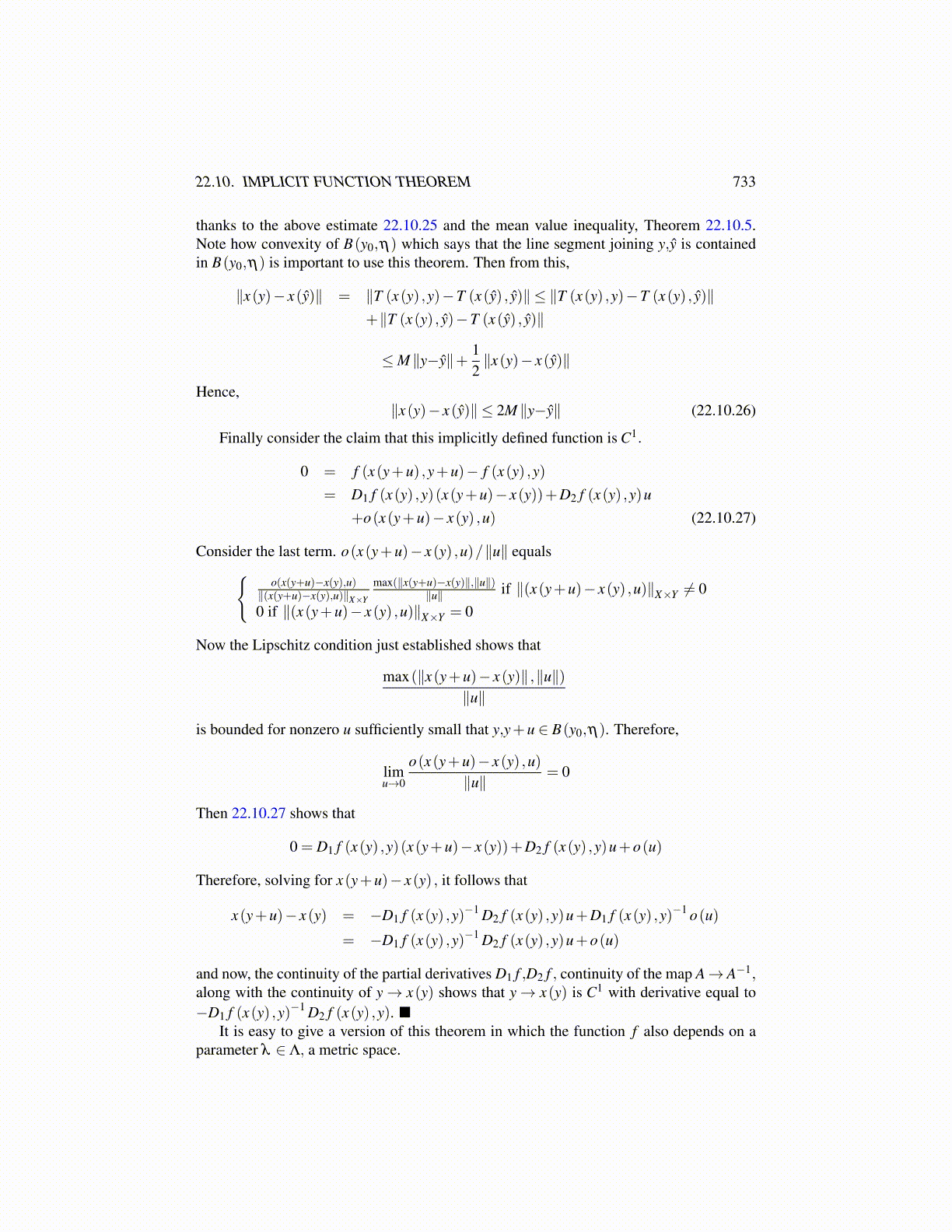
22.10. IMPLICIT FUNCTION THEOREM 733
thanks to the above estimate 22.10.25 and the mean value inequality, Theorem 22.10.5.Note how convexity of B(y0,η) which says that the line segment joining y,ŷ is containedin B(y0,η) is important to use this theorem. Then from this,
∥x(y)− x(ŷ)∥ = ∥T (x(y) ,y)−T (x(ŷ) , ŷ)∥ ≤ ∥T (x(y) ,y)−T (x(y) , ŷ)∥+∥T (x(y) , ŷ)−T (x(ŷ) , ŷ)∥
≤M ∥y−ŷ∥+ 12∥x(y)− x(ŷ)∥
Hence,∥x(y)− x(ŷ)∥ ≤ 2M ∥y−ŷ∥ (22.10.26)
Finally consider the claim that this implicitly defined function is C1.
0 = f (x(y+u) ,y+u)− f (x(y) ,y)
= D1 f (x(y) ,y)(x(y+u)− x(y))+D2 f (x(y) ,y)u
+o(x(y+u)− x(y) ,u) (22.10.27)
Consider the last term. o(x(y+u)− x(y) ,u)/∥u∥ equals{o(x(y+u)−x(y),u)
∥(x(y+u)−x(y),u)∥X×Y
max(∥x(y+u)−x(y)∥,∥u∥)∥u∥ if ∥(x(y+u)− x(y) ,u)∥X×Y ̸= 0
0 if ∥(x(y+u)− x(y) ,u)∥X×Y = 0
Now the Lipschitz condition just established shows that
max(∥x(y+u)− x(y)∥ ,∥u∥)∥u∥
is bounded for nonzero u sufficiently small that y,y+u ∈ B(y0,η). Therefore,
limu→0
o(x(y+u)− x(y) ,u)∥u∥
= 0
Then 22.10.27 shows that
0 = D1 f (x(y) ,y)(x(y+u)− x(y))+D2 f (x(y) ,y)u+o(u)
Therefore, solving for x(y+u)− x(y) , it follows that
x(y+u)− x(y) = −D1 f (x(y) ,y)−1 D2 f (x(y) ,y)u+D1 f (x(y) ,y)−1 o(u)
= −D1 f (x(y) ,y)−1 D2 f (x(y) ,y)u+o(u)
and now, the continuity of the partial derivatives D1 f ,D2 f , continuity of the map A→ A−1,along with the continuity of y→ x(y) shows that y→ x(y) is C1 with derivative equal to−D1 f (x(y) ,y)−1 D2 f (x(y) ,y).
It is easy to give a version of this theorem in which the function f also depends on aparameter λ ∈ Λ, a metric space.